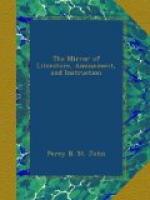of the
New Hebrides. In
New Caledonia
so great is the scarcity of food, that the natives
make constant war for the sake of eating their prisoners,
and sometimes, to assuage the cravings of hunger, they
bind ligatures tightly round their bodies and swallow
oleaginous earth. The
New Zealanders are
cannibals sometimes in a dearth, and to gratify a
spirit of vengeance against their enemies. The
New Hollanders, near the sea, subsist on fish
eaten raw, or nearly so; should a whale be cast ashore,
it is never abandoned until its bones are picked; their
substitute for bread, and that which forms their chief
subsistence, is a species of fern roasted, pounded
between stones, and mixed with fish. The general
beverage of the negro tribes is palm-wine. No
disgust is evinced by the
Bosjesman Hottentots
at the most nauseous food, and having shot an animal
with a poisoned arrow, their only precaution, previous
to tearing it in pieces and devouring it raw, is to
cut out the envenomed part. Half a dozen Bosjesmans,
will eat a fat sheep in an hour; they use no salt,
and seldom drink anything, probably from the succulent
nature of their food. The
Caffres live
chiefly on milk; they have no poultry, nor do they
eat eggs. When flesh is boiled, each member of
a family helps himself from the kettle with a pointed
stick, and eats it in his hand. Their substitute
for bread, which is made of Caffre-corn, a sort of
millet, is the pith of a palm, indigenous to the country.
The Lattakoos eat, with equal zest, the flesh
of elephants, rhinoceroses, tigers, giraffes, quaggas,
&c.; and sometimes, under an idea that it confers
valour, human flesh, of which they have otherwise
great abhorrence. They are very disgusting in
their manner of preparing food. The Abyssinians
usually eat the flesh of cattle raw, and sometimes,
although we believe the fact has been much controverted,
immediately as it is cut from the living animals.
The Bisharye, a tribe of Bedouin Arabs, eat
raw flesh, drink raw sheep’s blood, and esteem
the raw marrow of camels their greatest dainty.
The Patagonians eat raw flesh with no regard
to cleanliness. The Greenlanders subsist
on fish, seals, and sea-fowls, prepared and devoured
in manners truly disgusting; train-oil is their sauce,
and the blood of seals, their favourite beverage!
Some of the North American Indians diet on
the flesh of the sea-dog, parts of the whale and its
fat, and an oil made of the blubber of both of these
animals. Whilst, singular is the contrast, some
of the South American tribes, are able to digest
monkeys, blackened in, and dried by fire, to such a
degree of wood-like hardness, as to be rendered capable
of keeping, we dare not say how long.
Chacun a son gout, says one proverb, but we
trust that the readers of this paper will, whenever
they feel themselves inclined to quarrel with English
fare, pause, and remember, another, viz.:—“A
man may go further and fare worse.”




